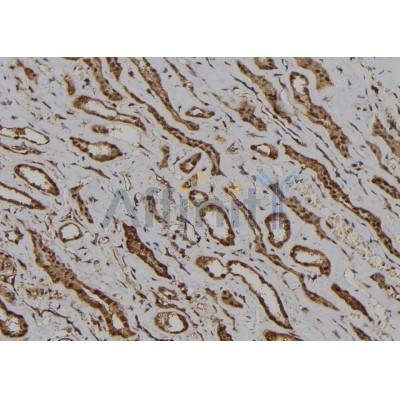Phospho-MyoD1 (Thr115) Antibody - #AF7233
| Product: | Phospho-MyoD1 (Thr115) Antibody |
| Catalog: | AF7233 |
| Description: | Rabbit polyclonal antibody to Phospho-MyoD1 (Thr115) |
| Application: | WB IHC IF/ICC |
| Reactivity: | Human, Mouse, Rat |
| Prediction: | Pig, Zebrafish, Bovine, Sheep, Rabbit, Dog, Chicken, Xenopus |
| Mol.Wt.: | 34kDa; 35kD(Calculated). |
| Uniprot: | P15172 |
| RRID: | AB_2843673 |
Related Downloads
Protocols
Product Info
*The optimal dilutions should be determined by the end user. For optimal experimental results, antibody reuse is not recommended.
*Tips:
WB: For western blot detection of denatured protein samples. IHC: For immunohistochemical detection of paraffin sections (IHC-p) or frozen sections (IHC-f) of tissue samples. IF/ICC: For immunofluorescence detection of cell samples. ELISA(peptide): For ELISA detection of antigenic peptide.
Cite Format: Affinity Biosciences Cat# AF7233, RRID:AB_2843673.
Fold/Unfold
bHLHc1; Class C basic helix-loop-helix protein 1; MYF 3; Myf-3; MYF3; Myoblast determination protein 1; Myod 1; MYOD; MYOD1; MYOD1_HUMAN; Myogenic differentiation 1; Myogenic factor 3; Myogenic factor MYF 3; Myogenin D1; PUM;
Immunogens
A synthesized peptide derived from human MyoD1 around the phosphorylation site of Thr115.
- P15172 MYOD1_HUMAN:
- Protein BLAST With
- NCBI/
- ExPASy/
- Uniprot
MELLSPPLRDVDLTAPDGSLCSFATTDDFYDDPCFDSPDLRFFEDLDPRLMHVGALLKPEEHSHFPAAVHPAPGAREDEHVRAPSGHHQAGRCLLWACKACKRKTTNADRRKAATMRERRRLSKVNEAFETLKRCTSSNPNQRLPKVEILRNAIRYIEGLQALLRDQDAAPPGAAAAFYAPGPLPPGRGGEHYSGDSDASSPRSNCSDGMMDYSGPPSGARRRNCYEGAYYNEAPSEPRPGKSAAVSSLDCLSSIVERISTESPAAPALLLADVPSESPPRRQEAAAPSEGESSGDPTQSPDAAPQCPAGANPNPIYQVL
Predictions
Score>80(red) has high confidence and is suggested to be used for WB detection. *The prediction model is mainly based on the alignment of immunogen sequences, the results are for reference only, not as the basis of quality assurance.
High(score>80) Medium(80>score>50) Low(score<50) No confidence
Research Backgrounds
Acts as a transcriptional activator that promotes transcription of muscle-specific target genes and plays a role in muscle differentiation. Together with MYF5 and MYOG, co-occupies muscle-specific gene promoter core region during myogenesis. Induces fibroblasts to differentiate into myoblasts. Interacts with and is inhibited by the twist protein. This interaction probably involves the basic domains of both proteins (By similarity).
Phosphorylated by CDK9. This phosphorylation promotes its function in muscle differentiation.
Acetylated by a complex containing EP300 and PCAF. The acetylation is essential to activate target genes. Conversely, its deacetylation by SIRT1 inhibits its function (By similarity).
Ubiquitinated on the N-terminus; which is required for proteasomal degradation.
Methylation at Lys-104 by EHMT2/G9a inhibits myogenic activity.
Nucleus.
Restrictive clause
Affinity Biosciences tests all products strictly. Citations are provided as a resource for additional applications that have not been validated by Affinity Biosciences. Please choose the appropriate format for each application and consult Materials and Methods sections for additional details about the use of any product in these publications.
For Research Use Only.
Not for use in diagnostic or therapeutic procedures. Not for resale. Not for distribution without written consent. Affinity Biosciences will not be held responsible for patent infringement or other violations that may occur with the use of our products. Affinity Biosciences, Affinity Biosciences Logo and all other trademarks are the property of Affinity Biosciences LTD.




